|
|
|
Sort Order |
|
|
|
Items / Page
|
|
|
|
|
|
|
| Srl | Item |
| 1 |
ID:
150462
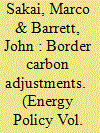

|
|
|
|
|
| Summary/Abstract |
Approximately one fourth of global emissions are embodied in international trade and a significant portion flows from non-carbon-priced to carbon-priced economies. Border carbon adjustments (BCAs) figure prominently as instruments to address concerns arising from unilateral climate policy. Estimating the volume of emissions that could be potentially taxed under a BCA scheme has received little attention until now. This paper examines how a number of issues involved in the implementation of BCAs can affect their ability to cover emissions embodied in trade and thus address carbon leakage. These issues range from ensuring compliance with trade provisions and assumptions on the carbon intensity of imports, to determining which countries are included and whether intermediate and final demand are considered. Here we show that the volume of CO2 captured by a scheme that involved all Annex B countries could be significantly reduced due to these issues, particularly by trade provisions, such as the principle of ‘best available technology’ (BAT). As a consequence, the tariff burdens faced by non-Annex B parties could dwindle considerably. These findings have important policy implications, as they question the effectiveness and practicalities of BCAs to reduce carbon leakage and alleviate competitiveness concerns, adding further arguments against their
|
|
|
|
|
|
|
|
|
|
|
|
|
|
|
|
| 2 |
ID:
168337
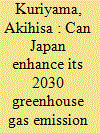

|
|
|
|
|
| Summary/Abstract |
This study investigates the stringency of Japan's greenhouse gas emissions reduction target for 2030 (nationally determined contribution: NDC), focusing on the macroeconomic assumptions of Kaya indicators and others previously overlooked, e.g. GDP per working-age population. It also conducts a decomposition analysis in light of historic political and economic events.
We find that the real GDP growth assumption underlying the NDC target is unrealistic. Namely, the real GDP per working-age population, which is an indicator of productivity, needs to be improved annually by 2.5% on average for 15 years, a high level that has not been observed since the collapse of the economic bubble in the early 1990s.
|
|
|
|
|
|
|
|
|
|
|
|
|
|
|
|
| 3 |
ID:
126606


|
|
|
|
|
| Publication |
2013.
|
| Summary/Abstract |
In the public sphere and the literature on climate strategies, the measurability of corporate GHG emissions tends to be taken for granted, and few empirical studies have examined the reliability of such data. The present case study, which was conducted among 10 Canadian companies considered as large final emitters and three auditing firms, focuses on the factors which could affect the perceived credibility of GHG inventories and the strategic implications of these. The qualitative, inductive study allows identifying three main factors which affect trust in business inventories: technical issues and complexity of GHG measurements, lack of transparency on the part of the companies and unreliability of verification mechanisms. The study also makes it possible to evaluate the implications of uncertainties concerning GHG inventories which are of strategic importance for companies and policy makers. While the reliability of GHG measurement is taken for granted at the political level, uncertainties in this area can in fact have a huge impact on the establishment of the cap and trade system. The study also contributes to the literature on carbon accounting by shedding light on underexplored ethical issues, including the lack of independence of auditors and its implications.
|
|
|
|
|
|
|
|
|
|
|
|
|
|
|
|
| 4 |
ID:
121318
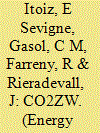

|
|
|
|
|
| Publication |
2013.
|
| Summary/Abstract |
In the frame of the European project titled "Zero Waste" (1G-MED08-533), a tool has been developed called CO2ZW for estimating the GHG emissions for the management of MSW at the municipal, regional or national levels with small amounts of input data. The objective of this paper is to demonstrate that the CO2ZW tool allows us to inventory and monitor GHG emissions from MSW following the IPCC guidelines for national inventories and the principles of life cycle assessment (LCA). The CO2ZW tool includes the key stages and parameters for calculating GHG emissions and includes several advantages regarding the implementation of the default values of the Mediterranean European countries, an improvement in accessibility (online free access) and two approaches for calculating GHG emissions from landfills. The results of this paper show that for countries with medium and high rates of deposition, implementation of the European policies limiting waste in landfills can contribute to mitigate climate change in a remarkable way. With the CO2ZW tool, it is possible to evaluate waste management choices depending on waste management infrastructures and waste policies, along with the quantification of GHG emissions from MSW management, which is essential to guide waste policy options and climate change solutions.
|
|
|
|
|
|
|
|
|
|
|
|
|
|
|
|
| 5 |
ID:
092726
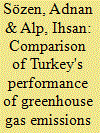

|
|
|
|
|
| Publication |
2009.
|
| Summary/Abstract |
Turkey signed the Kyoto Protocol on February 17th, 2009. Therefore, to fulfill the liabilities of the Kyoto Protocol, she has to review her status and make strategic plans to hold the emissions at the levels specified in the protocol. For this purpose, in this study employing data envelopment analysis (DEA), Turkey's greenhouse gas (GHG) emissions and local/regional pollutants compared to the European Union (EU) countries have been put in place. Since the data on Malta and Cyprus was inadequate, these two nations were excluded from the evaluation. As a candidate for EU, Turkey is required to reduce the emissions by 8% until 2012 within the framework of the Kyoto Protocol.
Two models were considered in this performance work: (i) the first model for the input energy consumption, GHG and local/regional pollutants (total GHG, CO2, F (emissions of non-methane volatile organic compounds), CO, NO2, SO2) has been considered as the output value. (ii) In the second model, the values entered in the sectoral energy consumption have been considered as GHG emissions and local/regional pollutants output. Model 2 was taken into account in which different inputs were employed to observe the impacts of input values causing GHG emissions on emission. DEA technique is used, which holds the output constant in the direction which should reduce the input. For this purpose, the effect of sectoral energy consumption on total emission was identified and it was aimed to identify on which energy resources the strategy developed for emission reduction should be.
|
|
|
|
|
|
|
|
|
|
|
|
|
|
|
|
| 6 |
ID:
136188


|
|
|
|
|
| Summary/Abstract |
The Shenzhen ETS is the first urban-level “cap-and-trade” carbon emissions trading scheme to operate in China. This paper gives an overview of the economic and emissions situation in Shenzhen and focuses on the development of the Shenzhen ETS regulatory framework. It is devised as an ETS with an intensity-based cap, output-based allocation and a market for trading of allowances. The design of the Shenzhen ETS attaches great importance to coordinate the dynamic relationships between economic growth, industrial transition and emissions control. The cap and its allocation are determined by carbon intensity reduction targets and economic output, with an aim to slow down emissions growth while mitigating shocks from economic fluctuation and industrial adjustment to market stability. The Shenzhen ETS features extensive coverage consisting of three types of regulated entities and four categories of covered emissions, in order to control carbon emissions by both improving energy efficiency and restraining growing energy demand. A competitive game theory method is created for allocation of free allowances to manufacturing enterprises. Mechanisms for carbon offsets and market stabilization are developed to promote active and orderly trading in the carbon market. Moreover, several challenges and their policy choices are detailed for the development of the Shenzhen ETS.
|
|
|
|
|
|
|
|
|
|
|
|
|
|
|
|
| 7 |
ID:
116957


|
|
|
|
|
| Publication |
2012.
|
| Summary/Abstract |
The European Union has unilaterally committed to a 20% reduction of the greenhouse gas emissions and another 20% increase in energy efficiency by 2020. This work presents Ecotax, an economic policy instrument that supports the simultaneous achievement of both objectives, in the building sector.
The proposed instrument is a tax/subsidy scheme attached to the difference between the actual emissions and a specified target. It uses market pricing to value emissions trading price, and is directly integrated into the energy efficiency certification scheme. Thus, minimizing the administrative costs of its establishment.
During the project phase, the tax/subsidy falls on the construction companies which facilitates the funding of innovation in technology. In the operation phase, it falls on proprietors or end-users, stimulating sustainable consuming habits. In both cases, the administration acts as an intermediary, channeling funds from low to high energy efficiency agents, inside and outside the sector itself.
Although the instrument is specifically proposed for the building sector, it is easily translatable to other sectors that are not necessarily included in the emission allowance trading scheme of the European Union.
|
|
|
|
|
|
|
|
|
|
|
|
|
|
|
|
| 8 |
ID:
177362
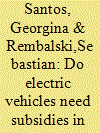

|
|
|
|
|
| Summary/Abstract |
We analyse the total cost of ownership of petrol, diesel, hybrid electric vehicles, plug-in hybrid electric vehicles and battery electric vehicles in the UK over 2017–2029. We do this for large, medium and small cars, under assumptions of 0%, 6%, 30% and 60% discount rates. We find that some electric car models from mass market brands are close to reaching cost parity with their petrol, diesel and hybrid counterparts, but subsidies would accelerate their uptake, especially for impatient consumers with high discount rates. Plug-in hybrid electric vehicles are not worth the effort because, although relatively low, their CO2 emissions are non-zero, and their purchase price is as high or even higher than that of battery electric vehicles. A subsidy of £4,500 or an exemption from the 20% VAT, perhaps capped at £4,500, would accelerate mass market penetration of battery electric vehicles in the UK. If decarbonising road transport were not as urgent as it is, the market for battery electric vehicles could be left to develop on its own, without government intervention. However, because the cost of batteries is not falling fast enough, subsidies are needed in the short term.
|
|
|
|
|
|
|
|
|
|
|
|
|
|
|
|
| 9 |
ID:
177426
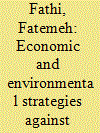

|
|
|
|
|
| Summary/Abstract |
This study sought to investigate the economic-environmental effects of Targeted Subsidy Policy on energy in the meat market of Iran within a game theory framework. The welfare of players in economic game, determined by equilibrium displacement model, and the environmental losses (benefits) from Greenhouse Gas emissions were considered as game payoffs based on the behavior of three players: producers, consumers, and government. Results show an increase in the piece of energy carriers as a policy deterred from enhancing environmental losses and reducing the welfare of each market player. Therefore, eliminating energy subsidy, and redistributing its revenue toward producers to improve technology are regarded as the government's strategy for economic-environmental equilibrium, while removing energy subsidy without repaying is considered as equilibrium strategy in which the effects of Targeted Subsidy Policy are only considered economically or environmentally.
|
|
|
|
|
|
|
|
|
|
|
|
|
|
|
|
| 10 |
ID:
132592


|
|
|
|
|
| Publication |
2014.
|
| Summary/Abstract |
Forecasting of electricity demand has assumed a lot of importance to provide sustainable solutions to the electricity problems. LEAP has been used to forecast electricity demand for the target year 2030, for the state of Maharashtra (India). Holt's exponential smoothing method has been used to arrive at suitable growth rates. Probable projections have been generated using uniform gross domestic product (GDP) growth rate and different values of elasticity of demands. Three scenarios have been generated which include Business as Usual (BAU), Energy Conservation (EC) and Renewable Energy (REN). Subsequent analysis on the basis of energy, environmental influence and cost has been done. In the target year 2030, the projected electricity demand for BAU and REN has increased by 107.3 per cent over the base year 2012 and EC electricity demand has grown by 54.3 per cent. The estimated values of green house gas (GHG) for BAU and EC, in the year 2030, are 245.2 per cent and 152.4 per cent more than the base year and for REN it is 46.2 per cent less. Sensitivity analysis has been performed to study the effect on the total cost of scenarios. Policy implications in view of the results obtained are also discussed.
|
|
|
|
|
|
|
|
|
|
|
|
|
|
|
|
| 11 |
ID:
117274
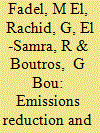

|
|
|
|
|
| Publication |
2013.
|
| Summary/Abstract |
This paper examines the implications of renewable energy (RE) deployment in power generation for residential consumption in the Middle East and North Africa (MENA) region under various RE penetration targets. A comparative assessment revealed a great heterogeneity among countries with Turkey dominating as the highest emitter. At the sub-regional level, the Middle East sub-region contributes more than double the GHG emissions estimated for the Gulf and North Africa sub-regions with all sub-regions achieving reductions in the range of 6-38% depending on the RE target penetration and promising up to 54% savings on investment excluding positive externalities associated with the offset of greenhouse gas (GHG) emissions savings.
|
|
|
|
|
|
|
|
|
|
|
|
|
|
|
|
| 12 |
ID:
121279
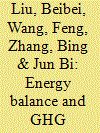

|
|
|
|
|
| Publication |
2013.
|
| Summary/Abstract |
Cassava-based fuel ethanol (CFE) is playing an increasingly important role in renewable transportation energy in the Guangxi Province in China. Previous studies have evaluated the energy and greenhouse gas (GHG) performance of CFE, but they have largely overlooked the influences of different agricultural planting modes. In this study, five scenarios related to cassava planting modes were selected to evaluate the lifecycle energy balance and GHG emissions of the CFE system. The results show that, although all the five CFE scenarios show positive net energy values (NEV) and GHG emissions savings compared with the conventional gasoline, the planting modes have significant impacts on their energy and GHG performance. Modes that are considered intensive (i.e. high fertilizer use intensity and highly mechanized harvesting) generally show poorer performance than the extensive ones, primarily because of the intensive energy consumption and GHG emissions during nitrogen fertilizer production, the N2O emission of nitrogen fertilizer use, and higher yield loss rate caused by mechanized harvesting. This study shows that it is important to evaluate the planting modes when producing bioethanol in order to gain an understanding of the life-cycle energy use and GHG performance.
|
|
|
|
|
|
|
|
|
|
|
|
|
|
|
|
| 13 |
ID:
103403
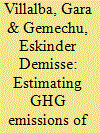

|
|
|
|
|
| Publication |
2011.
|
| Summary/Abstract |
In recent years, GHG inventories of cities have expanded to include extra-boundary activities that form part of the city's urban metabolism and economy. This paper centers on estimating the emissions due to seaports, in such a way that they can be included as part of the city's inventory or be used by the port itself to monitor their policy and technology improvements for mitigating climate change. We propose the indicators GHG emissions per ton of cargo handled or per passenger and emissions per value of cargo handled as practical measures for policy making and emission prevention measures to be monitored over time. Adapting existing methodologies to the Port of Barcelona, we calculated a total of 331,390 tons of GHG emissions (CO2 equivalents) for the year of 2008, half of which were attributed to vessel movement (sea-based emissions) and the other half to port, land related activities (land-based emissions). The highest polluters were auto carriers with 6 kg of GHG emissions per ton of cargo handled. Knowing the highest emitters, the port can take action to improve the ship's activities within the port limits, such as maneuvering and hotelling. With these results, the port and the city can also find ways to reduce the land-based emissions.
|
|
|
|
|
|
|
|
|
|
|
|
|
|
|
|
| 14 |
ID:
132667


|
|
|
|
|
| Publication |
2014.
|
| Summary/Abstract |
The article focuses on the interplay between two factors giving rise to friction in bioenergy governance: profound value disagreements (e.g. the prioritizing of carbon concerns like worries over GHG emissions savings over non-carbon related concerns) and regulatory complexity (in terms of regulatory measures and options). We present ethical and legal analyses of the current stalemate on bioenergy governance in the EU using two illustrative cases: liquid biofuels for transport and solid biomass-based bioenergy. The two cases disclose some similarities between these two factors, but the remaining differences may partly explain, or justify, contrasting forms of governance. While there seems to be no easy way in which the EU and national governments can deal with the multiple sustainability issues raised by bioenergy, it is argued that failure to deal explicitly with the underlying value disagreements, or to make apparent the regulatory complexity, clouds the issue of how to move forward with governance of bioenergy. We suggest that governance should be shaped with greater focus on the role of value disagreements and regulatory complexity. There is a need for more openness and transparency about such factors, and about the inherent trade-offs in bioenergy governance.
|
|
|
|
|
|
|
|
|
|
|
|
|
|
|
|
| 15 |
ID:
098594
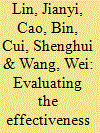

|
|
|
|
|
| Publication |
2010.
|
| Summary/Abstract |
To assess the effectiveness of urban energy conservation and GHG mitigation measures, a detailed Long-range Energy Alternatives Planning (LEAP) model is developed and applied to analyze the future trends of energy demand and GHG emissions in Xiamen city. Two scenarios have been designed to describe the future energy strategies in relation to the development of Xiamen city. The 'Business as Usual' scenario assumes that the government will do nothing to influence the long-term trends of urban energy demand. An 'Integrated' scenario, on the other hand, is generated to assess the cumulative impact of a series of available reduction measures: clean energy substitution, industrial energy conservation, combined heat and power generation, energy conservation in building, motor vehicle control, and new and renewable energy development and utilization. The reduction potentials in energy consumption and GHG emissions are estimated for a time span of 2007-2020 under these different scenarios. The calculation results in Xiamen show that the clean energy substitution measure is the most effective in terms of energy saving and GHG emissions mitigation, while the industrial sector has the largest abatement potential.
|
|
|
|
|
|
|
|
|
|
|
|
|
|
|
|
| 16 |
ID:
116924


|
|
|
|
|
| Publication |
2012.
|
| Summary/Abstract |
In this paper we use a technological model of Ireland's future car stock to simulate the impact of a range of policy measures on the baseline trend in energy demand in the period to 2030. The policies and measures modelled comprise meeting deployment targets for electric vehicles and compressed natural gas vehicles, an EU regulation for the improvement of vehicle efficiency, implementation of a national biofuel obligation, as well as several behavioural measures (encouraging modal shifting and reduced travel demand). The impact of the different measures simulated is measured in terms of their contribution to meeting Ireland's ambitious targets for energy savings, for renewable energy penetration and for greenhouse gas (GHG) emissions reductions. The results point to a possible improvement of 32% in car stock efficiency, the achievement of 7.8% renewable energy share of road and rail transport and a 22% reduction in non-ETS private car CO2 emissions relative to 2009 levels. A scenario analysis on meeting the EV penetration target shows a significant range of CO2 emissions reductions depending on the cars (and mileage) displaced and on the electricity generation portfolio.
|
|
|
|
|
|
|
|
|
|
|
|
|
|
|
|
| 17 |
ID:
124603


|
|
|
|
|
| Publication |
2013.
|
| Summary/Abstract |
The current increasing importance of road transport in the overall greenhouse gas (GHG) emissions has led to the adoption of diverse policies for the mitigation of global warming. These policies focus in two directions, depending on whether they involve the reduction of emissions or the mitigation through carbon dioxide (CO2) sequestration. In this paper, the Tier 3 methodology from the European Monitoring and Evaluation Programme and the Environment Agency (EMEP/EEA) was applied to determine the evolution of Spanish motorway GHG emissions in the period 2005-2010. According to the results, though the average daily traffic (ADT) is the major parameter, the average fleet age and vehicle size also affect the level of emissions. Data analysis also revealed a clear connection between the decrease in European trade volume during the financial crisis and the GHG release, despite its temporary character. Among the three improvement scenarios evaluated, reduced speed limit seems the most direct measure while the consequences of afforestation strongly depend on the traffic density of the stretch of the motorway considered. Finally, technological improvement requires a drastic change in the fleet to obtain substantial decrease. The combination of different policies would allow a more robust strategy with lower GHG emissions.
|
|
|
|
|
|
|
|
|
|
|
|
|
|
|
|
| 18 |
ID:
112911
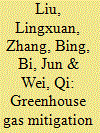

|
|
|
|
|
| Publication |
2012.
|
| Summary/Abstract |
Climate mitigation at the local level plays a highly important role in greenhouse gas (GHG) emissions mitigation. This research presents a summary of the local efforts in China's ecological industrial parks (EIPs) to assess GHG emissions and identify potential mitigation measures. Through field study and interviews in Suzhou Industrial Park (SIP), in Jiangsu Province, we conducted an energy-based GHG emissions inventory for SIP area from 2005-2010, with forecasts to 2015. The area emitted a total of 10.30 MMT CO2E in 2010. Three development strategies including business-as-usual (BAU), existing and pending regulations (EPR) and voluntary mitigating efforts (VME) were introduced to estimate the energy-related GHG emissions in 2015. The results projected that emissions will increase to 17.16 Mt in 2015 with no change in policy or practice, but 3.42 Mt of emissions are avoidable with full compliance with national and provincial energy policies (1.41 Mt), as well as local efforts (2.01 Mt). This study furthers the understanding of the potential effectiveness of carbon reduction strategies of industrial parks in China, including the development industrial symbiosis (IS) and on-site renewable energy projects.
|
|
|
|
|
|
|
|
|
|
|
|
|
|
|
|
| 19 |
ID:
186438


|
|
|
|
|
| Summary/Abstract |
The electrification of the car fleet is an essential transformation to a meaningful reduction of greenhouse gas emissions in road transport. This has been a major goal of European transport policies, but other actions can also enhance the effectiveness of EVs to reduce emissions. In this paper we analyse four key European and German transport policies and assess how these could be improved to increase their potential to reduce emissions. Using iterative feedback from 12 interviews across various stakeholder groups, we have developed proposals for revised policies on electric vehicles. The results show that current policies in the EU and Germany are not making use of the full environmental potential of EVs, because they do not differentiate sufficiently between different EVs, and have been designed for the era of combustion vehicles. We suggest that the introduction of a new Bonus-Malus Registration Scheme and the overhaul of the existing Road Tax System are the most promising changes both in terms of their potential to reduce emissions and their likelihood of adoption.
|
|
|
|
|
|
|
|
|
|
|
|
|
|
|
|
| 20 |
ID:
125847


|
|
|
|
|
| Publication |
2013.
|
| Summary/Abstract |
Like cities, many large national parks in the United States often include "urban" visitor and residential areas that mostly demand (rather than produce) energy and key urban materials. The U.S. National Park Service has committed to quantifying and reducing scopes 1 and 2 emissions by 35% and scope 3 emissions by 10% by 2020 for all parks. Current inventories however do not provide the specificity or granularity to evaluate solutions that address fundamental inefficiencies in these inventories. By quantifying and comparing the importance of different inventory sectors as well as upstream and downstream emissions in Yosemite National Park (YNP), this carbon footprint provides a case study and potential template for quantifying future emissions reductions, and for evaluating tradeoffs between them. Results indicate that visitor-related emissions comprise the largest fraction of the Yosemite carbon footprint, and that increases in annual visitation (3.43-3.90 million) coincide with and likely drive interannual increases in the magnitude of Yosemite's extended inventory (126,000-130,000 t CO2e). Given this, it is recommended that "per visitor" efficiency be used as a metric to track progress. In this respect, YNP has annually decreased kilograms of GHG emissions per visitor from 36.58 (2008) to 32.90 (2011). We discuss opportunities for reducing this measure further.
|
|
|
|
|
|
|
|
|
|
|
|
|
|
|
|
|
|
|
|
|